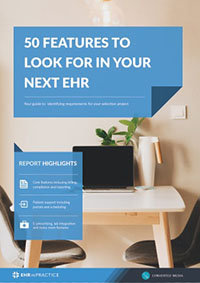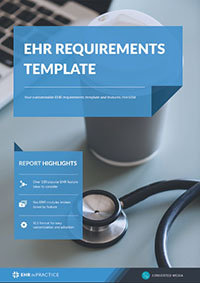Key EHR innovations to improve patient experience
Electronic Health Record systems since their inception, have been bridging the gap between the providers and the patients, streamlining workflows and expediting patient care from the first point-of-contact to the last. According to Deloitte’s Global Health Care Outlook 2018 report, per-patient health care spending is expected to gradually increase from $9,237 to $ 11,356 in the year 2021. Considering the forthcoming pace of health care in the U.S, providers should be able to showcase agility in adapting to the influx of patients, for over the years to come. To ensure a futuristic and a superior practice, physicians are encouraged to reflect upon the key innovations that an EHR entails, take a look below:
Better decisions lead to better health care
Clinical decision support tools (CDS) help physicians in making crucial decisions with regard to their patients. Refill alerts are seamlessly scheduled for patients and are cross-referenced with the patient’s database for the possibility of any potential allergies that may cause complications. Patient portal, a core component of CDS, enables patients to schedule their own appointments and view their data online, which greatly reduces wait time and enhances productivity.
Fast-tracking vaccinations
According to the National Center for Biotechnology Information (NCBI) research, clinical alerts have rapidly increased the use of influenza vaccinations pragmatically from 0% to 35%, over a short span of time. Moreover, patients who fall under the age bracket of 35 months to 19 years of age, completed 15 vaccinations out of the 19 vaccinations which they were supposed to complete. Achieving a success rate of 68.4%, all made possible due to the utilization of an EHR solution.
Data automation for fluid workflows
Computerized physician order entry (CPOE) systems enable providers to input orders, such as lab tests, drugs etc., through the use of computers rather than the conventional method of data entry (paper charts, manual data entry etc.). Research suggests that through the usage of an EHR solution, medication errors can be minimized by as much as 55%, which is possible if only the CPOE system is used. But if both the CDS and the CPOE systems are utilized in a synergistic manner, the percentage of errors falls to a remarkable 17%. Implementation of such a system ensures the validity of the data being entered, and as a result, guarantees a fluid practice.
Preemptive care for better results
EHR systems are configured with an integrated application known as the patient portal, which is designated to facilitate patients in every possible manner. Patient portal acts as a safe haven for patients, with round-the-clock appointment scheduling, provision of real-time patient data such as demographics etc., and online lab results. Basic EHR functionalities alongside specialty-specific EHR capabilities, help providers in improving their general health care services.
Quality reduces costs
With better access to labs, there are fewer chances of duplication of data, hence reducing costs and thus consistently improving the quality of health care being delivered to the patients. Such errors cost the health care industry about $19.5 billion a year. EHR systems help providers to stay on track with the latest preventive treatment and measures, and clinical alerts. Also providing them with a new and improved view of potential patient data such as patient charts based on weight, cholesterol etc.
Specialty-specific health care
Many EHR systems offer specialty–specific functionalities which facilitate providers and staff in saving their precious time by focusing on the specialty which best suits their needs. Customized forms for specialty experts, helps them see more patients and increase their efficiency by structuring data within less time. Consequently, cloud-enabled EHRs provide physicians with secure access to their data 24/7/365.
Increase provider’s return and revenue
With its implementation, providers can expect to see more patients by up to 27%, according to the active-patients-to-clinician-FTE (full-time equivalent) ratio – based on NCBI’s research. In addition to this, providers have higher chances of recovering their EHR investment within the first year of its implementation.
Sharing of information
Interoperability ensures the availability of data to all the stakeholders of the health care services such as pharmacies, labs, insurance companies etc. How this helps is simply put forward by the fact that unnecessary readmissions are prevented and medication errors are avoided. Moreover, HIPAA compliance supports the electronic exchange of information, the functionality of contagious disease tracking and the active participation of data in cancer categories. Moreover, through the implementation of the protected health information clause; data is automatically safeguarded against any potential breaches which may occur in the future.
Data analytics
Predictive analysis and machine learning are aiding providers and health care agencies such as Centers for Disease Control and Prevention (CDC), in combating diseases and in the provision of prompt health care services. Use of such technology is helping keep autoimmune diseases such as HIV at bay; through the analysis of the data collected. In the future, wearable technology is expected to increase the accuracy of the data captured, through the collection and analysis of potential insights in real time.
Free white paper

50 features to look for in your next EHR
A comprehensive guide to EHR features and how they can benefit your practice

Featured white papers
Related articles
-

EHR requirements and key features: your complete guide
Our extended guide to EHR requirements - everything you need to know and more on the subject
-

What are the core functions of EHR
The basic functionality that your EHR should include
-

The most important EHR features for practice management
The key functionalities any practice management software should have



